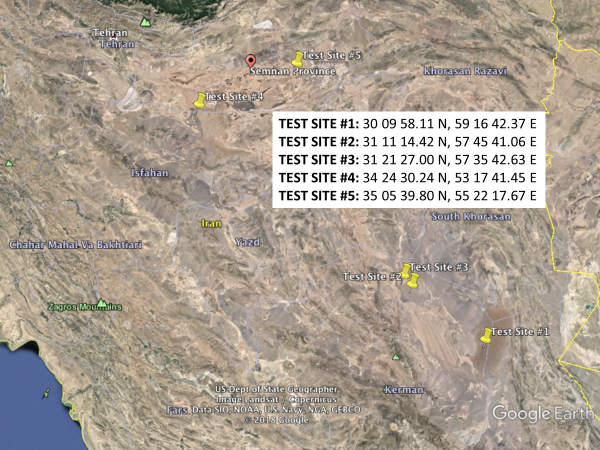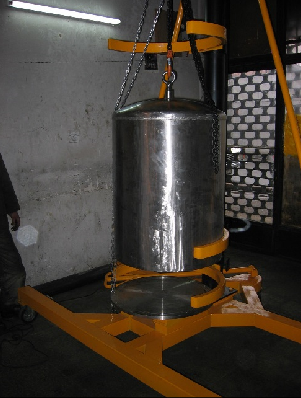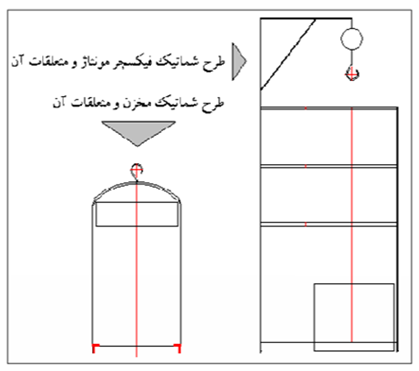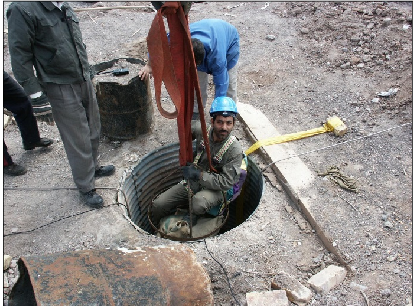Reports
Summary of Report: Project Midan: Building an Underground Nuclear Test Site in Iran [1]
by David Albright, Sarah Burkhard, Olli Heinonen, Frank Pabian, and Andrea Stricker
April 25, 2019
An important discovery in the Nuclear Archive seized by Israel was substantial evidence that Iran was building an underground nuclear test site that was expected to be finished by 2004. Iran’s nuclear weapons program, code-named the “Amad Plan,” was developing and building five nuclear weapons, and this program wanted to be ready to test one, if a decision was made to do so. Starting in late 2000, Project Midan, the test program’s code name, created an extensive program to develop and construct an underground test site and instrument it so that the nuclear explosive yield could be determined. Project Midan conducted nuclear test site selection, identified five potential test site locations, built testing-related equipment, and focused on developing approaches, including seismic and other methods, to measure the yield of an underground nuclear test. Despite evidence that Iran had made significant progress on being able to test a nuclear explosive underground, we could not determine with our geospatial satellite imagery analysis and currently available documentation whether construction of a deep shaft started. The work on building a test site appears to have halted when the Amad Plan was downsized and reoriented in late 2003.
Given the existence of a post-Amad nuclear weapons program, however, it is logical to assume that Iran may have continued to maintain preparedness to test and work on developing yield prediction methods after 2003. These efforts would be expected to fall in line with the post-Amad reorientation guidelines found in archive documents that aimed to secretly blend certain nuclear weapons activities into civilian programs at universities and research institutes, and maintain separate, secret military programs for other activities that could not be explained by contrived civil or nonnuclear military rationales.


Figure 1. Left: A document in the archive, overlain on a Google Earth image of Iran, shows the four areas considered for an underground test site. This was refined further to five specific locations, which are numbered 1 through 5 from south to north on the inset on left image. Right: Another archive document provides the coordinates for these five sites, which the Institute used to geo-locate them in Google Earth.
Test Site Selection
Iran’s test site project, with at least one deep shaft, involved several tasks that can be identified in the archive documents. Project Midan picked four potential areas for an underground test site, with five smaller locations within these areas selected for consideration (Figure 1).
Theoretical Work and Development of Equipment and Capabilities
Iran extensively evaluated the theoretical aspects of building a nuclear test site. It assessed the necessary shaft depth for a particular explosive yield, the behavior of the ground and soil during drilling and an explosion, the methods of back filling a shaft after the emplacement of a nuclear device, and software development.
A cylindrical metal container was built to hold an object and position it over a shaft. The dimensions of the container would be sufficient to hold a nuclear device, although likely not large enough to hold physics and electronics packages (Figure 2). This raises the question of whether this system was a mockup or a scaled down version, part of designing a final system.
In addition, according to the IAEA, “Iran has conducted a number of practical tests to see whether its EBW [Exploding Bridge Wire] firing equipment would function satisfactorily over long distances between a firing point and a test device located down a deep shaft.” 2 These tests would have likely required the construction of detonator systems connected to long cables.


Figure 2. Left: Photo from the archive showing the container and assembled test carrying device. Right: Diagram of a carrying device schematic from the archive. The two lines in Farsi read: The design schematic for fixture assembly (top). Schematic of the container and its accessories (bottom).
Nuclear Explosive Yield Estimation
Information in the archive describes how the Iranians measured the explosive yield of a detonation through seismic, radiochemical, and hydrodynamic methods.
Based on available archive documentation, the most developed method was seismic. In addition to extensive relevant seismic research and analysis, Iran conducted three high explosive tests in a remote area of Iran. These tests, which involved up to five tons of high explosive, were likely aimed at seeing how the detonations would record locally at Iran’s nearby seismic stations as a way to calibrate explosive yield to seismic signals. Figure 3 shows the location of the high explosive tests relative to the five potential underground nuclear test sites and one of several images in the archive showing high explosive test preparation.


Figure 3. Left: The location of the high explosive tests in the project to develop seismic methods of measuring a nuclear explosive yield. Right: Archive image showing preparation for one of the tests. The shafts were 30 meters deep.
Iran was also evaluating radiochemical methods to produce accurate yield estimates, but based on the available archive documents, this work did not advance very far. However, several slides from the archive reveal that Iran was using information from other nuclear weapons programs to explore this topic, including the procedures used to estimate the yield of the 1998 purported thermonuclear test at the Pokhran underground test site in India.
Findings and Recommendations
The archive documentation reveals an Iranian program to build a nuclear test site in the early 2000s that was further along than previously thought, at least publicly. But it also raises questions. Did the digging of a deep shaft commence? Where is the equipment shown in the archive images located today? Is it being stored? What diagnostic equipment was built, and where is it today? Is there a group of Iranian experts dedicated to maintaining a capability to build a nuclear test site while honing its skills at instrumenting that test and hiding the site from detection? These questions deserve to be answered.
The information supports earlier findings that Iran violated its commitments under the Nuclear Non-Proliferation Treaty as well as a new finding that Iran’s actions were not compatible with the spirit of its commitments as a signatory of the Comprehensive Test Ban Treaty. The International Atomic Energy Agency (IAEA), the Preparatory Commission for the Comprehensive Nuclear-Test-Ban Treaty Organization (CTBTO), and their member states need to understand how far Iran’s underground testing program progressed and its status today.
As we have recommended throughout this effort to understand the archives, the new information derived from the Iranian Nuclear Archive adds more urgency to efforts to create a correct and complete history of Iran’s nuclear weapons efforts; obtain answers from Iran about the fate of the equipment, material, technology, and personnel discussed in the archive; and, more broadly, to characterize the Amad Plan and its successor programs.
Iran may have had, and still may have now, undeclared nuclear materials and facilities – a finding the IAEA reiterates every three months in its quarterly reports on the Iran nuclear deal. It is therefore essential that the IAEA Board of Governors requests the Secretariat to verify in a timely manner the existence of the documents in the archive, their contents, and related equipment to ensure that all nuclear material and activities have indeed been declared to the IAEA, and all non-peaceful activities have been terminated and relevant capabilities dismantled.
The IAEA should be asked to verify sites, locations, facilities, documentation, equipment, and materials mentioned in the archive, question personnel involved, and report on that work. Iran should be urged to cooperate fully in these investigations. It is essential that the IAEA Secretariat reflects on Iran’s progress in its quarterly reports so that the Board of Governors can exercise its oversight function.
The Preparatory Commission for the CTBTO should look at Iran’s past nuclear testing activities. Via consultation and clarification, and requests for on-site visits, the Preparatory Commission should seek to determine the history and status of Iran’s nuclear weapons testing program. Such an effort from Iran would support its claims that its nuclear program is peaceful
Additional summaries of our Iran Nuclear Archive analyses can be found here.
[1] Read the full report here: David Albright, Sarah Burkhard, Olli Heinonen, Frank Pabian, and Andrea Stricker, “Project Midan: Developing and Building an Underground Nuclear Test Site in Iran,” Institute for Science and International Security and Foundation for Defense of Democracies, April 2, 2019. (http://isis-online.org/isis-reports/detail/project-midan-developing-and-building-an-underground-nuclear-test-site-in-i/8; https://www.fdd.org/analysis/reports/2019/04/02/project-midan/)
2. IAEA Director General, “Implementation of the NPT Safeguards Agreement and relevant provisions of Security Council resolutions in the Islamic Republic of Iran,” GOV/2011/65, November 8, 2011. (http://www.isis-online.org/uploads/isis-reports/documents/IAEA_Iran_8Nov2011.pdf) ↩

 twitter
twitter